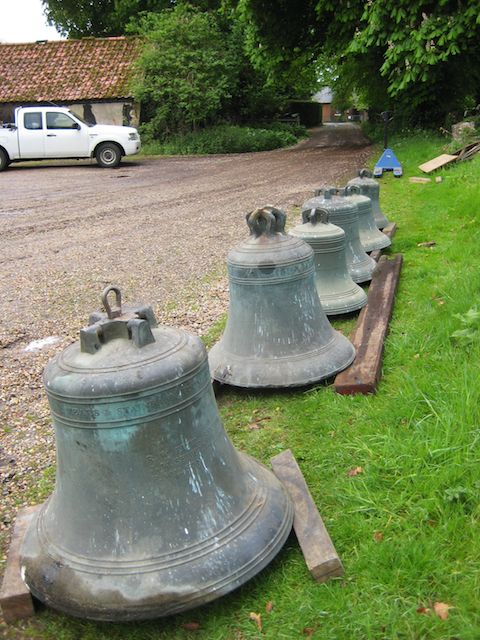On Thursday 23rd of May, early in the morning, six bells were taken from the church – five never to return, one to be re-furbished so it can be hung as the clock bell.
In the days preceding their departure the bells were, in all probability, seen by more people than in the previous 105 years combined.
On Saturday 18th May ringers from the village and surrounding area spent two hours ringing the bells for the village – 24 people came to the church to ring and watch the ringers – many more villagers heard the bells as they rang out across the village.
On Sunday 19th May the bells were rung for the last time before the 09.30 Service. Click here for details of the bell-ringing team on this day.
On Monday 20th May two gentlemen from the Whitechapel Bell Foundry arrived to begin the task of removing the bells from the tower. A system of chains and pulleys was put in place once the floor panels had been moved to create a space for the bells to descend. This system allowed just two men to safely remove bells weighing several tonnes.
The bells were lowered to the floor of the ringing chamber, wheeled out of the external door to the ringing chamber and back into the church for storage. After the bells had last been hung, the Steward Memorial was fitted to the doorway linking the ringing chamber to the inside of the church. The addition of the Memorial means that it was not possible to bring the bells directly into the church from the ringing chamber. Of the six bells removed from the tower five made it through the outside door with ease, one, the tenor bell, was just a little bit too big. If you look closely about 6 inches from the bottom of the outside doorway you will notice a fresh gouge in the stonework – this was caused when the tenor bell, two inches, a mere 5cm too wide, was brought out of the ringing chamber. It is testament to the skills of the Whitechapel Foundry that one very small gouge is all the evidence that one bell was too large for the doorway.
On the 22nd of May we were delighted to welcome the children from the village school to the church. Peter and Neil from The Whitechapel Foundry kindly talked to the children about bells, how they are made and hung in the tower and also took questions including:
How do you get the bells down? Using a system of pulleys and chains – each bell takes about twenty minutes to bring down.
How did you get them into the church? Each bell in turn was put on a trolley and wheeled out of the ringing chamber’s outside door, around the side of the church and in through the front door using a ramp.
How old are the bells? The oldest is dated 1616 and the newest 1908.
How big is the largest bell? The tenor bell is the largest – it weighs 8 cwt and is 5cm wider than the outside door to the ringing chamber!
How do you get rid of the old bells? The bells are smashed with 28lb and 56lb hammers. The metal is then melted down in the furnace to make new bells.
How long does it take to smash a bell? This depends on the size of the bell and the metal composition. A small bell can be smashed in 20 minutes, a large one may take a whole day.
What percentage of tin is used? Between 18 and 24% of the metal is tin. 20 to 22% produces the best bells.
Have you ever hit yourself with a hammer? No, but the blacksmith has!
Later on in the afternoon and again in the evening volunteers opened the church for anyone to come and view the bells.
On Wednesday 22nd May 38 school children, 5 staff from the school and a total of 43 visitors from the village and surrounding area saw the bells – a great send off!
On Thursday 23rd May the bells were loaded onto a flatbed lorry (along with another Norfolk bell from the church at North Tuddenham) ready to be transported to the foundry in London. It was “Goodbye” to five of the bells – their inscriptions and details will be carefully recorded at the foundry – the sixth, originally cast in 1616, will be renovated and prepared for hanging as the clock bell later in the year.
At 3pm a team of volunteers arrived to sweep up and tidy the old fittings and fixtures away. At the next meeting of the PCC it will be decided what will happen with the fixtures and fittings, current ideas include selling the fittings at the church fête (as memorabilia, for artists to use as a base for sculpture, to create a garden feature, any other creative use!) and using some of the wood to make souvenir pens. We will keep you informed as to the fate of the fittings and fixtures and give you plenty of notice so you may have the opportunity to obtain a piece of Saxlingham history!





















